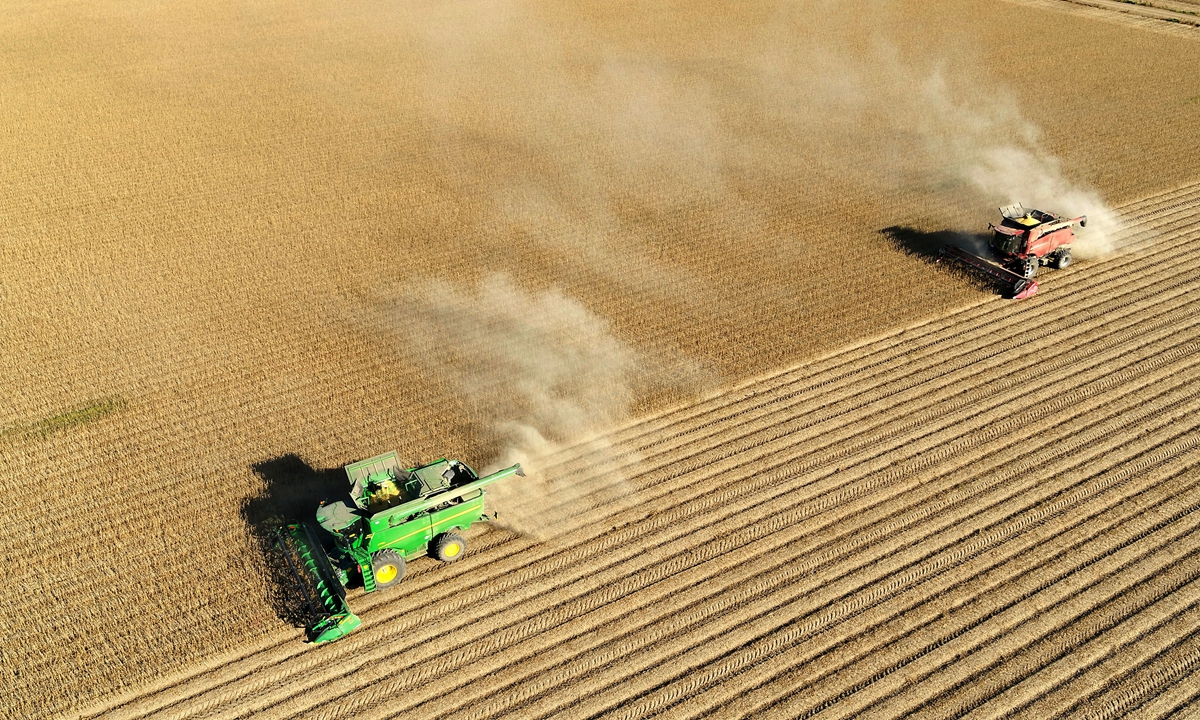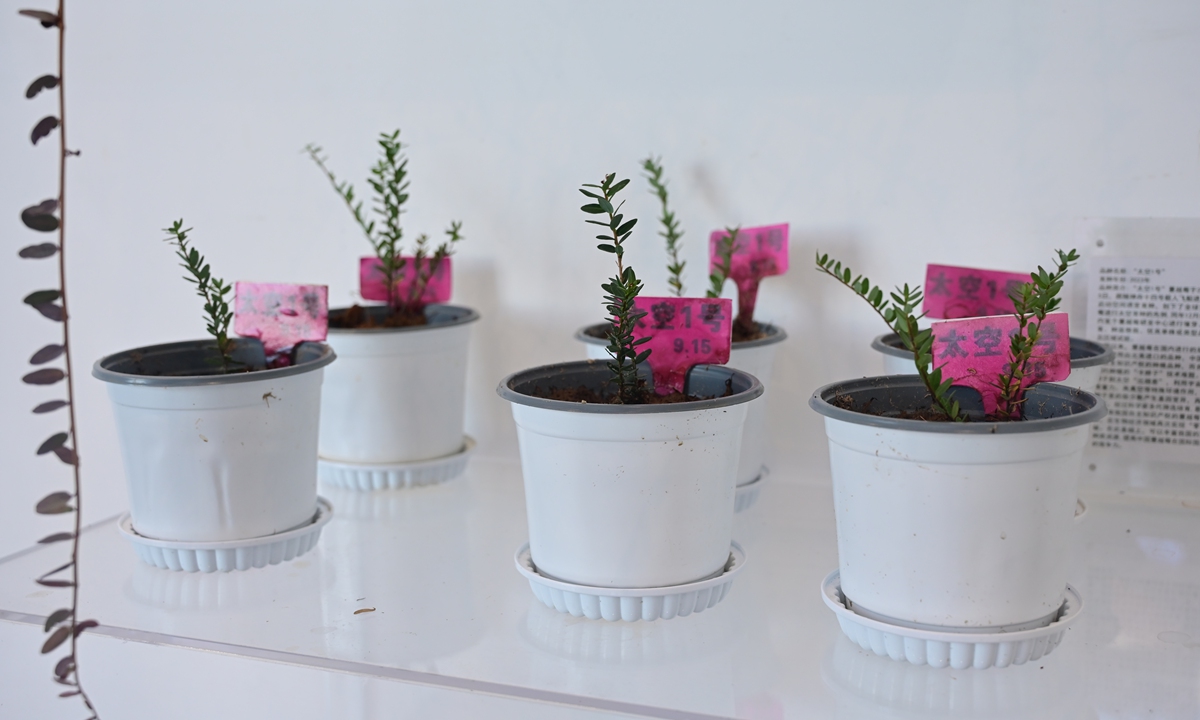Editor's Note: With the global economy, including China's, facing challenges, some Western politicians and media outlets have stepped up smear campaigns against the world's second-largest economy. They selectively highlight information and distort facts to promote their narratives like "Peak China," while ignoring China's economic resilience and growth potential. To set the record straight, the Global Times is launching a multimedia project featuring in-depth articles, analyses and visual arts to provide a balanced and accurate portrayal of the Chinese economy. This is the 17th installment of the series.

Combine harvesters in full swing harvesting soybeans in Heihe, Northeast China's Heilongjiang Province on September 21, 2024. Photo: IC
Feeding China's 1.4 billion people with total planting areas making up only about 13 percent of the country's total territory is a challenging task.
The Report to the 20th National Congress of the Communist Party of China noted that China must reinforce the foundations for food security on all fronts, including invigorating the seed industry, supporting the development of agricultural science, technology, and equipment.
In 2021, Chinese Academy of Agricultural Sciences (CAAS) released an action plan drawing on science and technology to promote the country's seed industry. The plan focuses on improving seed varieties, grain yield and germplasm protection, seed-source self-sufficiency, and core technology innovation.
The Global Times recently paid a visit to one of China's most important grain output regions - Heilongjiang Province in Northeast China - and saw how agricultural technology would further lift the province's field output to shore up the country's grain security.
For many years, soybean production has drawn the public's rising attention, as the crop has become a vital bargaining chip between countries.
Heihe in Heilongjiang, a major soybean production base in China, with local planting area accounting for one seventh of the country's total, just witnessed another bumper harvest in autumn.
Scientific approachesLocated in a high latitude area, Heihe has insufficient photothermal conditions for growing crops. However, benefiting from the relentless efforts of local agricultural researchers, the far-flung city has overcome natural disadvantages and turned agriculture into a strength through agricultural tech innovations.
Jia Hongchang joined the Heilongjiang Academy of Agricultural Sciences (HAAS) Heihe branch after graduating from university in 2004, and he has dedicated himself to soybean breeding for about two decades.
The responsibility of Jia and his fellow researchers is to breed new soybean varieties for the fourth to sixth thermal zones in the province, with new and higher-quality seeds approved nearly every year, Jia told the Global Times, adding that advanced soybean varieties are introduced to other parts in China.
The "Heike-43" is a high-quality soybean seed bred by HAAS Heihe branch, and has the largest annual planting area in the fourth thermal zone nationwide, covering about 10 million mu (666,666 hectares) annually, Jia said.
As the largest city in China for soybean production, Heihe's soybean planting area accounts for one-third of Heilongjiang Province, and the city's soybean output makes up one-seventh of the national total.
In 2024, the total soybean planting area in Heihe reached 1.38 million hectares. To improve yield per unit area, the local government collaborated with multiple agricultural research institutes to improve soybean seeds and they succeeded.
The average yield of ordinary soybean seeds remains at around 150 kilograms per mu, said Jia, noting that by introducing new soybean varieties bred by the academy, along with a series of other supporting planting technologies, the average yield in the northern regions of Heilongjiang has steadily increased to over 200 kilograms per mu now.
Agricultural tech innovations continue to drive China's field output as their contribution rate currently stands at 63.2 percent, according to data released by China's Ministry of Agriculture and Rural Affairs in September this year.
Last year, the agricultural mechanization rate in Heilongjiang Province reached 99.1 percent, ranking first in China. In 2024, the province also reported 33,000 registered agricultural-use drones, ranking the first nationwide, the Heilongjiang Daily reported.
Encouraged by the growing harvest of Heihe's soybeans, multiple agricultural institutes from other provinces have set research centers in the city to invest more to achieve scientific and technological breakthroughs to ensure China's soybean output, Jia noted.
"Boosted by high-yield seeds and supported by non-stop agricultural technology innovations, Heihe's role as a prime base of the nation's soybean production will be further solidified," he said.

Cranberry seedlings grew by space bred seeds display at the Red Sea Farm on October 12, 2024. Photo: Tao Mingyang/GT
Space breedingLi Feng operates a cranberry farm in Fuyuan, the easternmost city in Heilongjiang, with largest cranberry growing area in Asia reaching 280 hectares.
The Red Sea Farm, Li's company, introduced and digested cranberry planting technologies from North America about 10 years ago. The farm got the spotlight and caught the national attention in late 2023 due to the ice and snow travel feast there.
"High-quality cranberry seeds abroad often face strict export control measures," said Li, noting that as seed is actually the "microchip of agriculture," fostering a cranberry seed variety with self-owned intellectual property rights is essential for the independent development of his farm.
With the rapid development of China's space endeavors, Li has seen greater hopes. In June 2022, a total of 50,000 cranberry seeds from the Red Sea Farm were sent into Earth's low-orbit boarding the Shenzhou-14 spacecraft, a precedent for cranberry space breeding.
By utilizing the special conditions available in space, including cosmic rays, microgravity, and high vacuum, a small number of the seeds undergo genetic mutations.
Upon returning to Earth, scientists conduct multiple rounds of selection and cultivation, ultimately resulting in the development of high-yield cranberry varieties.
Following the space trip, cranberry seeds are now planted for no less than four generations to select a variety to be developed into a superior mutant strain with consistent genetic traits, Li said. Currently, the seeds coming back from space are still being cultivated, according to Li.
To achieve independent development for the company's cranberry planting, Li has invited engineers to design and make planting machines that are better suited to local conditions. At the same time, agricultural scientists at the Institute of Natural Resources and Ecology of Heilongjiang Academy of Sciences have been providing guidance and assistance to help Heilongjiang farmers improve cranberry yields.





